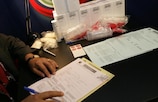2014 WADA prohibited list
Tuesday, December 31, 2013
Article summary
The World Anti-Doping Agency (WADA) has issued a new list of prohibited substances and methods, which is set to come into effect on 1 January 2014.
Article top media content

Article body
The World Anti-Doping Agency (WADA) has issued a new list of prohibited substances and methods, which will come into effect on 1 January 2014.
The Prohibited List – which can be found in the supporting documentation on the right of the page – specifies substances and methods prohibited in sport. Implementation of the list is mandatory for organisations that have adopted the World Anti-Doping Code.
The 2014 list contains some changes compared to the 2013 list. It should be noted that with regards to prohibited substances:
• The nomenclature of some substances on the list has been updated to International Non-proprietary Names (INN). For ease of the reviewer, the previous name has been included and no substance has been deleted.
• In category "S1. Anabolic Agents", changes were made to the definitions of "exogenous" and "endogenous" for purposes of clarification and accuracy.
• In category "S2. Peptide Hormones, Growth Factors and Related Substances", points S2.2, S2.3 and S2.4 make clear that releasing factors are prohibited. In addition, other prohibited growth factors are listed separately.
• Vasopressin V2 antagonists (vaptans) have been added as an example of a diuretic subclass in category "S5. Diuretics and other Masking Agents".
• In "S6. Stimulants", some drugs that metabolise to amfetamine or methamfetamine have been reclassified (from non-specified to specified) because improved analytical techniques permit the identification of the administered drug and corresponding metabolites; MDMA and MDA are reclassified because they are now recognised as less likely to be used as doping agents; cathinone and its analogues and trimetazidine have been added as examples to reflect emerging patterns of drug use.
With regards to prohibited methods, the term allogenic was introduced to section "M1. Manipulation of Blood and Blood Components" for the purpose of scientific accuracy.
Impact of these changes on Therapeutic Use Exemption (TUE) procedure
Despite changes to the Prohibited List, UEFA's procedure for granting TUEs remains the same as in 2013. Players participating in UEFA competitions, or in senior-level international friendly matches, who have to use a prohibited substance or method for therapeutic purposes, must request prior authorisation from UEFA.
TUE application forms must be duly completed and signed by the player and their doctor, and should then be sent with all relevant medical evidence to the UEFA Anti-Doping Unit. Only in well founded and documented cases of medical emergency can players be administered a prohibited substance before applying for a TUE.





